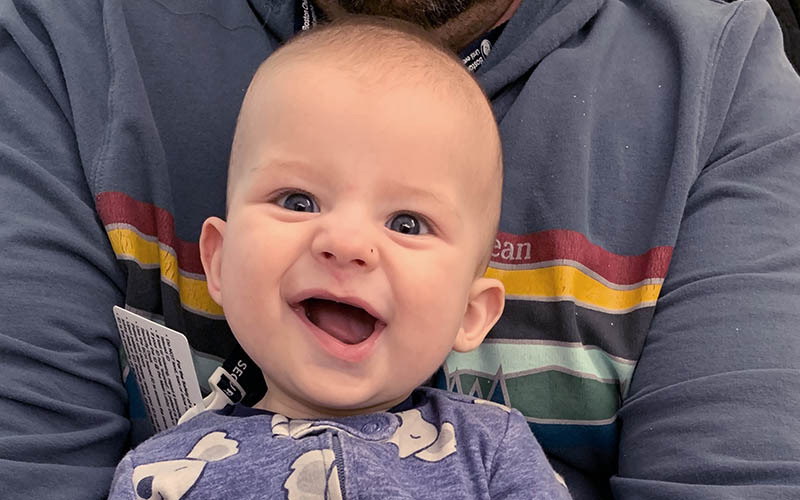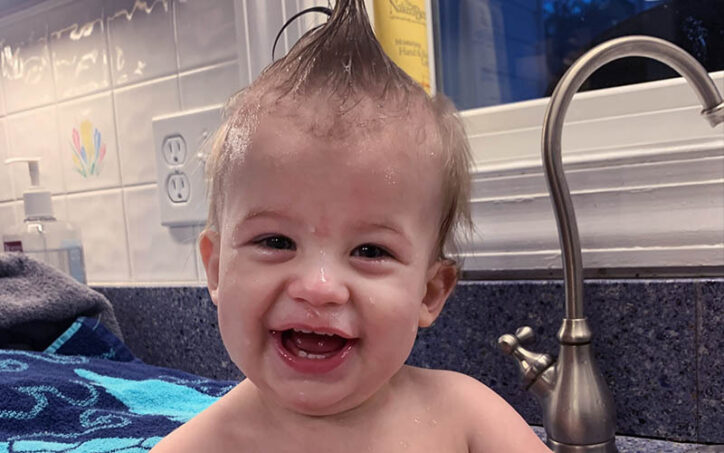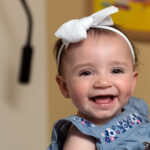Maternal-fetal care helps ‘All Smiles Myles’ beat a CPAM

Myles Gifford is “fearless and defiant,” says his mother, Katy. “We’ll be in big trouble when he’s a teenager,” she laughs. “But it’s benefited him so far.” In fact, Myles, now more than 18 months old, needed to draw on his perseverant personality almost as soon as he was born.
Katy, her husband, Mike, and their then-2-year-old son, Logan, were looking forward to having another baby boy. But during a routine 20-week ultrasound in their home state of Vermont, they learned that Myles’ heart appeared to have developed on the right side of his body. It was unexpected and startling news. “I kind of blacked out for a moment,” says Katy.

Finding care and looking forward
Further testing in the Giffords’ local hospital’s maternal-fetal medicine department brought mixed news: Myles did not have a heart defect. Instead, he had a significant congenital pulmonary airway malformation (CPAM), an abnormal mass of tissue that develops in the lung. CPAMS have no known cause but don’t have a genetic basis or run in families. While most CPAMs are benign, some can become life threatening if they grow too large because they can affect the development of the surrounding organs. In Myles’ case, the mass was large enough to push on his heart, moving it closer to the right and putting him at risk for a type of heart failure called hydrops.
While their local hospital had dealt with a handful of CPAM cases, the Giffords wanted more expertise. In search of more specialized care, the family reached out to the Maternal Fetal Care Center (MFCC) at Boston Children’s Hospital. They met with the team, including surgeon Dr. Terry Buchmiller and registered nurse Olivia Oppel, to learn more about their options. Only two weeks had passed from the initial diagnosis, but in that time the mass had nearly doubled. Because the CPAM had increased significantly in such a short time, steroids were administered to help slow its growth.
Needless to say, the anxiety level for the Giffords and their extended family was high. The stress was compounded by the COVID pandemic restricting contact with family and friends. “The MFCC team was great,” says Katy. “They were always available and laid out each step in the process. It was hard for me to accept that this was something that just happened and I couldn’t have prevented. They helped show me what I could do and kept us looking forward. They became wonderful stand-ins for medical and emotional support.”
Against the odds
Katy was able to return to her home in Vermont for several weeks before Myles was born. During this time, she underwent two to three ultrasounds every week at her local hospital to track the size of CPAM and monitor for hydrops. While the CPAM didn’t shrink, it did stop growing, but Myles did not — and, seemingly against all odds, Myles did not develop hydrops. At 37 weeks, the Giffords, including Logan, temporarily relocated to the Boston area so Katy could deliver Myles in a hospital equipped to deal with any issues upon birth.
Due to the size of the CPAM, the MFCC team determined the safest method of delivery was a scheduled C-section with both Katy’s doctors and Boston Children’s teams on standby. However, “Myles had other plans,” says Katy. Four days before the scheduled C-section, Katy went into labor. Because she had already had one vaginal delivery, and because the team determined that Myles was handling the labor fine, the C-section was cancelled and Myles made his arrival on his own time and terms.
And there was another surprise: Because he was stable, Myles wouldn’t undergo surgery to remove the CPAM for several months. “This was a wonderful outcome, because we had budgeted and planned to be in Boston immediately after the birth for up to eight weeks, while Myles underwent surgery and recovery,” says Katy. The family was able to return home to Vermont for a few months. There, they waited while bonding with Myles and making sure he didn’t experience breathing difficulties or other concerns.

In the best possible hands
When Myles was about 4 months old, he underwent surgery to remove the mass. Although it was a long day for the Giffords, filled with emotional ups and downs, they knew their son was in the best possible hands. “We were so anxious,” remembers Katy. “But we knew that Dr. Buchmiller had performed this same procedure countless times before.” After approximately one week recuperating in the hospital with many wonderful nurses, doctors, and specialists overseeing his care, the family again headed home for Vermont.
Today, Myles is a daredevil, impish, little brother with no lingering evidence of his condition or surgery, besides a thin white scar. Out of precaution, he sees a pulmonologist in Vermont but will not need to return to Boston for several years — unless he just wants to visit. For now, he’s too busy jumping in his pool, playing with his big brother, cats, and dogs, dancing to his favorite songs, and generally being goofy. “His daycare,” says Katy, “calls him ‘All Smiles Myles.’”
Learn more about the Maternal Fetal Care Center.
Related Posts :
-

‘I did it!’ Micah is thriving after maternal-fetal care for a CPAM
Dr. Marla Lipsyc-Sharf is no stranger to the field of medicine: As a medical oncology fellow, she’s familiar with ...
-

From Cape Verde for coordinated CDH care
Most parents have never heard of congenital diaphragmatic hernia (CDH), a rare and potentially life-threatening condition in which a baby ...
-

Making it through the fight: Scarlett's CDH journey
Like her name suggests, Scarlett Virginia Moulton “has a lot of fire,” says her mother, Olivia. “She always has a ...
-

‘Our silver lining’: Mila is thriving after CDH repair
For Katie, last St. Patrick’s Day wasn’t an occasion for revelry. Instead, it was the day an ultrasound ...





